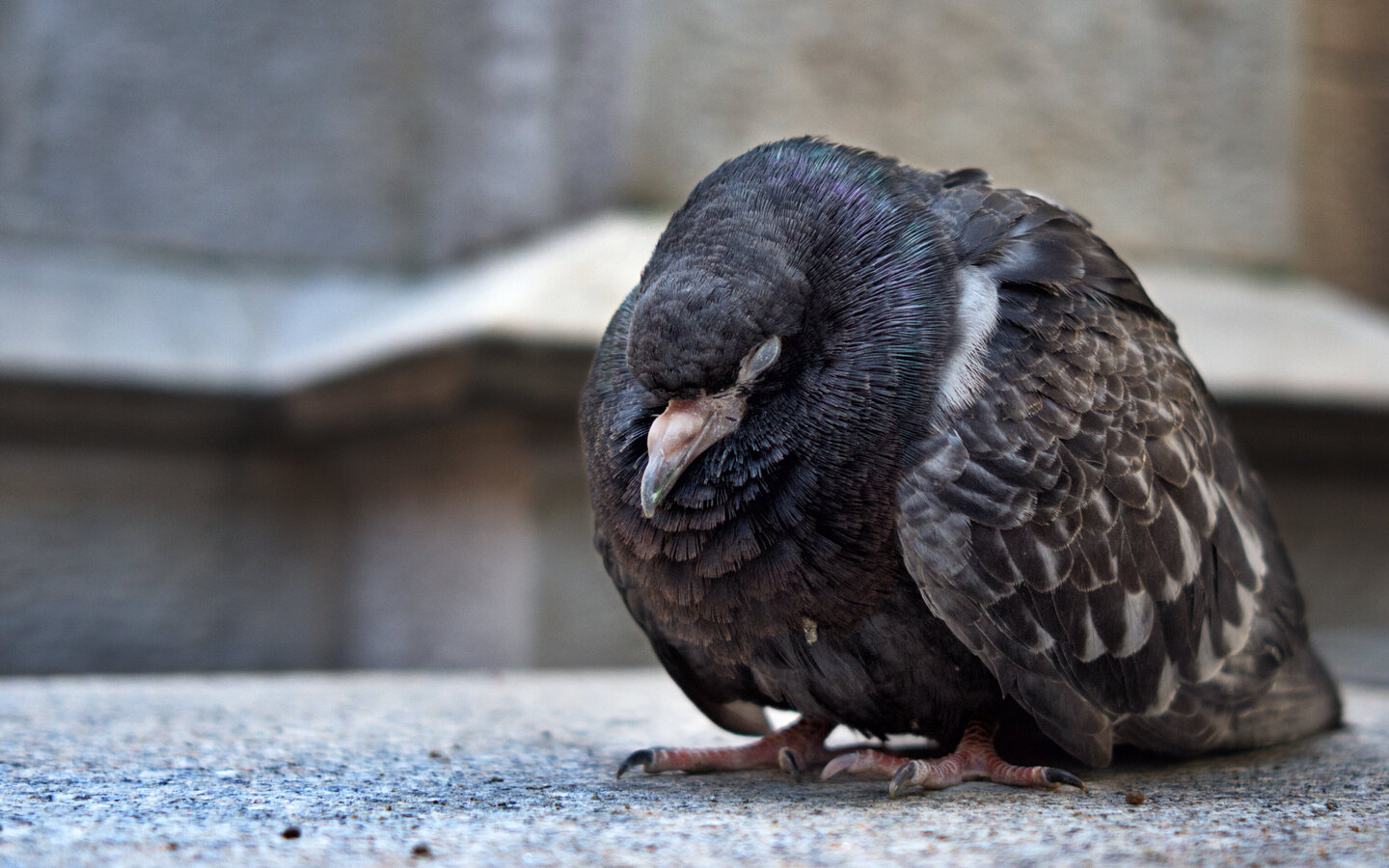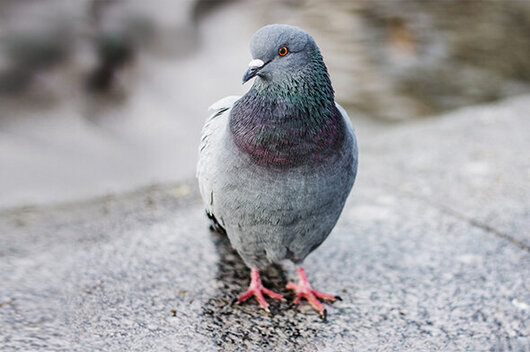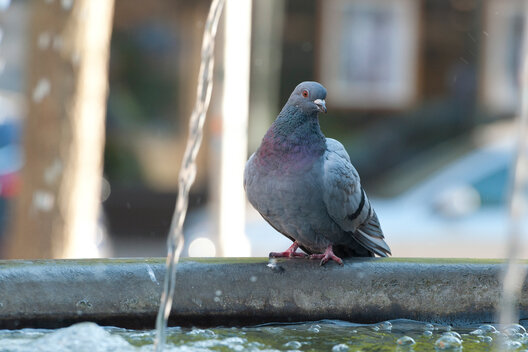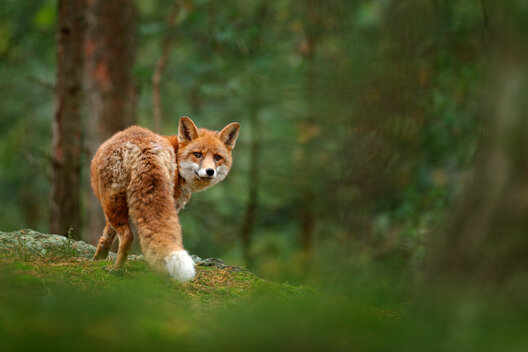Why pigeons in cities are dependent on helpEverything about urban pigeons
Pigeons are a symbol of peace and love. However, this positive image does not carry over to our everyday behavior towards urban pigeons. On the contrary, the birds suffer from a bad reputation. They are scared away or even deliberately killed. Yet pigeons are lovable, intelligent and adaptable animals1.
It is impossible to imagine cities without pigeons². However, their negative image is unjustifiably persistent: many people fear that they could transmit diseases and feel annoyed by them. They often disparage the animals as "rats of the air". However, pigeons pose no greater danger than other wild animals in the city. In truth, they need our help and our respect³.
Where do urban pigeons come from?
The urban pigeons we see in pedestrian zones and train stations are domesticated birds. This is because they are not wild birds, but the offspring of domestic pigeons that have flown away or been abandoned. They are originally descended from the rock pigeon, whose natural habitat is caves and rugged cliffs. For thousands of years, people in many regions of the world have bred and kept pigeons to use them for their meat, eggs, feathers or to transmit messages⁴. Around the second half of the 20th century, the keeping of domestic pigeons was largely abandoned and the animals were left to fend for themselves. Nevertheless, they still need the support and care of us humans today.
Helping pigeons in need
- In urban areas, pigeons often suffer from injuries. For example, hair or strings get wrapped around their legs, which can even cause them to lose their limbs. But not every pigeon that behaves conspicuously is sick or needs our help. In general, it is important to observe the situation calmly and only then take action. If you find a sick or injured pigeon, it is best to ask an animal welfare organization in your area how and whether you can help the animal.
- Depending on the situation, for example in the case of bleeding injuries, it may be necessary to catch the pigeon immediately. If you do this yourself, proceed carefully. It is best to use a cloth and place the animal in a cardboard box with air holes for transportation to a veterinary practice. Pigeons often have offspring that would be left helpless without their parents. It is therefore important to remember exactly where the pigeon was found. In this way, the pigeon can later be released in the same place and find its nest and its permanent partner, with whom it usually stays together for the rest of its life.
Do pigeons make people ill?
Many people fear that pigeons are increasingly transmitting diseases. However, this fear is unjustified. It has been scientifically proven that the risk of infection from pigeons is no greater than that from other birds or pets such as dogs or cats. Diseases from which they suffer can mainly only be dangerous for other pigeons. They definitely pose no risk to healthy humans.
How pigeons have to cope in cities
Pigeons in cities are usually on their own and have to cope with harsh living conditions. The food available - waste and food scraps from uncovered garbage cans, snack bars and schoolyards - is neither sufficient nor species-appropriate for the large number of animals. In some cities, people scatter wheat, rice, birdseed and maize. But even this food is often not enough to completely cover the pigeons' nutritional requirements. In addition, the food can spoil quickly depending on the weather or due to contamination. The result is malnutrition, which manifests itself in the thin "starvation droppings" that annoy many people.
Pigeon control and killing
Many cities and people try to drive pigeons away from buildings using means that are detrimental to animal welfare, such as nets or so-called spikes - spikes on roofs and window sills. Such defensive measures are usually not only ineffective, as they only move the breeding grounds to neighboring buildings. They also often mean an agonizing death for the animals. Time and again, pigeons are also victims of deliberate violence. In illegal killing operations, for example, grains poisoned with hydrocyanic acid are scattered or pigeons are caught in nets and killed at dawn. This is not only a criminal offense, but also completely inefficient. This is because the populations recover after just a few weeks.
This is what the German Animal Welfare Federation demands
A concept for peaceful coexistence between pigeons and humans in cities is the only sensible solution - this is the only way to regulate the population and help the pigeons. This requires species-appropriate places to live. It is therefore best for cities and municipalities to erect pigeon houses and towers where the animals can also get suitable food and fresh water. Pigeons are loyal to their habitat: they do not normally like to leave their familiar habitats. They stay where they grew up or where their partner and nest are located. The pigeon houses should be around ten to 20 meters high, not in the immediate vicinity of tall trees or in hollows. It is also important that animal welfare professionals look after them properly and that veterinary checks are carried out regularly.
If the pigeons are satisfied with their breeding opportunities, a so-called egg exchange can be carried out to regulate the population. This involves exchanging freshly laid eggs in the nests for plastic eggs. It is also important to have contact points for citizens to turn to with questions and problems.
Sources
¹ Iwasaki, S., Watanabe, S. & Fujita, K. Pigeons (Columba livia) know when they will need hints: prospective metacognition for reference memory?. Anim Cogn 21, 207–217 (2018).
² PIGEONS' DISCRIMINATION OF PAINTINGS BY MONET AND PICASSO Watanabe et al; Journal of the Experimental Analysis of behaviour / Volume 63 Issue 2
³ Orthographic processing in pigeons (Columba livia) Scarf et al 2016
⁴ Giunchi, D., Mucci, N., Bigi, D., Mengoni, C., & Baldaccini, N. E. (2020). Feral pigeon populations: their gene pool and links with local domestic breeds. Zoology, 142, 125817




